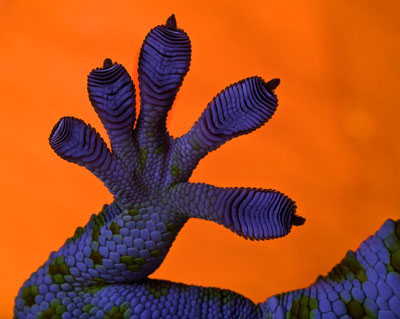| Sep 06, 2011 |
New project explores adhesion mechanisms to rough surfaces
|
|
(Nanowerk News) The little yellow self-adhesive notes are common companions in daily office life; but they stick only to smooth surfaces such as paper, windows, mirrors or screens. Geckos, insects and spiders do even better: They stick to walls and ceilings and move along them. Hair-like fibrils covering their feet allow these animals to not only "stick" headfirst to glass and smooth surfaces but also move along walls with woodchip wallpaper due to the fact that the hair-like fibrils branch out further into even finer structures.
|
|
Scientists at INM – Leibniz Institute for New Materials will now reproduce such "hierarchical" structures in a new project granted recently by DFG.
The project will join forces between two INM groups – Functional Surfaces (led by Prof. Arzt) and Structure Formation (directed by Dr. Kraus).
|
 |
| Sticking like a gecko.
|
|
For this purpose, the scientists will test the structures for their adhesive force using specifically developed measurement methods. In order to understand why hierarchical structures provide a better adherence, the scientists also use computer-based models. "In this project, we seek to find out the best way of developing hierarchical structures, and we seek to analyze what these structures are able to do – with this we aim to understand why adhesion to rough surfaces is possible at all," explains Eduard Arzt, the Scientific Director of INM and Head of the Program Division "Functional Surfaces".
|
|
Basically, the principle of gecko adhesion is known. It is based on many thin hair-like structures with varying diamteres which provide a better adherence than thick structures. "Imagine a brush, whose bristles branch out downwards getting thinner and thinner," explains Tobias Kraus, Head of the Junior Research Group "Structure Formation at Small Scales". "With their rough bristles, they sweep off big stones. In order to remove fine dust or sand, they sweep with less pressure so that the fine bristles catch the dust," says Kraus. And the same applies to the gecko: The animal uses fine fibrils for fine unevenness and rough fibrils for rough unevenness.
|
|
"At the present state of the art, it is no longer a problem to fabricate structures with only one 'fibril size'," says Arzt. For this purpose, the scientists use a molding technique. A liquid polymer is filled into a template of the "fibrils", where it hardens. The finished cast is then removed from the template. The result is a surface on which "fibrils" of the same size are arranged regularly.
|
|
With a new method, the scientists also seek to fabricate a branching into even finer fibrils. "The challenge is to produce a regular and narrow-spaced structure of these finest branches in the template," says the Chemical Engineer Kraus. Layer by layer, the scientists thus receive even more branched structures, starting with the thickest bristle.
|
|
Background
|
|
The project "Adhesion Mechanisms in Micropatterned Dry Adhesives with Hierarchical Structure" is one of 14 projects promoted by Germany's largest research funding organization DFG (Deutsche Forschungsgemeinschaft) in its priority program "Biomimetic Materials Research: Functionality by Hierarchical Structuring of Materials" (SPP 1420). In this program, leading groups from Germany explore the special properties of natural materials evolving from hierarchical structures. In addition to the scientists from INM, further top-class international scientists from the USA and a Humboldt scholarship holder are involved in this project, which started in August 2011.
|

